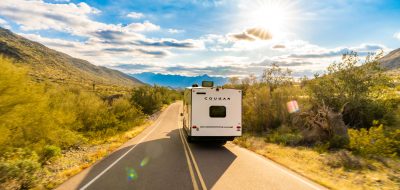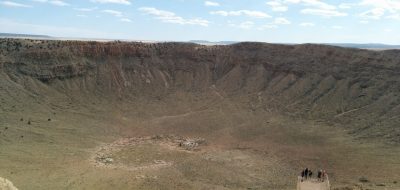Because February is Top 10 Month at RV.net, here is a helpful list of do’s and don’ts to remember when visiting state parks (actually, they’re relevant for national parks too).
 10. Do wear appropriate clothing for the day’s activities. Sensible, comfortable shoes are a must for any outdoor activity (no high-heels on a dirt trail, ladies). Proper attire can prevent hypothermia, frostbite, and sunburn, as well as minimize the risk of illness from ticks and poisonous plants. Always bring an extra pair of socks!
10. Do wear appropriate clothing for the day’s activities. Sensible, comfortable shoes are a must for any outdoor activity (no high-heels on a dirt trail, ladies). Proper attire can prevent hypothermia, frostbite, and sunburn, as well as minimize the risk of illness from ticks and poisonous plants. Always bring an extra pair of socks!
9. Do drink plenty of water. Even if it’s not that warm outside, the wind and sun can dry out your body and leave you weak or disoriented. Extreme dehydration can be deadly when not corrected promptly. Just make sure your water is from a clean source: always sanitize fresh water from streams or rivers, no matter how clear they look. You don’t want a painful case of giardia!
8. Do stay on marked trails. Park officials and volunteers work hard to maintain trails for your safety and convenience. If you get lost or injured off the trail, it will take much longer for search parties to find you. Trails also protect the park environment by limiting human disturbances to specific areas and away from fragile ecosystems and animal habitats.
7. Don’t pick the wildflowers. Many species of native plants are rare and undergoing conservation efforts. Although the flowers are lovely, picking them weakens the plant and may eliminate a source of food or shelter for nearby animals.
 6. Don’t feed the animals. Wild animals need to fear humans to survive on their own. We’ve all seen and heard accounts of wildlife getting too close to people in search of food, injuring a person(s) and then getting exterminated by animal control officials. This rule exists both for your own good and for the welfare of the local wildlife.
6. Don’t feed the animals. Wild animals need to fear humans to survive on their own. We’ve all seen and heard accounts of wildlife getting too close to people in search of food, injuring a person(s) and then getting exterminated by animal control officials. This rule exists both for your own good and for the welfare of the local wildlife.
5. Do what you can to prevent fires. Be mindful of campfires and cigarette butts—especially in dry brush/forest areas. All it takes is one rogue spark or ember to burn thousands of acres. Completely extinguish all sources of fire before leaving the area or turning in for the night. Read campfire tips.
4. Do get a map from the ranger/park office. That way you’ll be able to find your way to the points of interest and you’ll be less likely to get lost on your way back. Oftentimes maps are free with park admission and they make great mementos of your fun trip.
3. Don’t litter. Trash cans exist for a reason. If you can’t find one nearby, hold on to your trash until you do. Littering makes the park ugly and can make wild animals sick.
2. Do inquire about park pet regulations before bringing your pet with you to the park. Most parks limit pets to the front areas, if they allow them into the park at all. Some parks may have kennels to house your pet during your visit, but you will probably be charged for their use. Remember, parks limit pet access to protect the pet and to protect park wildlife by keeping them separated.
1. Do have fun and take lots of photos! Remember you are there to enjoy your surroundings and bond with your companions. Take a photo of that scenic vista to show the folks back home. Better yet, have another park visitor take a group photo of your posse in front of a park landmark/attraction so you’ll have another way to remember your trip.






Christina Bullock
Ah yes, the “Respect Your Neighbors” rule. It seems so obvious, yet people too often forget it. Those night-owl partiers don’t realize that their obnoxious violation of park quiet hours could get them thrown out of the campground! I often find that those people are the same ones who leave the campsite a mess. Rude people are usually rude across the board, unfortunately.
I do make exceptions for novice campers who just don’t know camping etiquette. They are usually very apologetic when you gently point out their mistake and suggest the proper way to do things. This way, you are passing on your knowledge and there is one less group of rude campers out there to annoy the rest of us!
GlenO
All 10 great points. Likewise to expand on William’s comment of respect your neighbor, this for sure is a Great One also. I have been in a couple situations where the neighbor numerous trailers down would be partying with rather loud music and in some cases into the late hours. I like country music but to my levels.
William Whitcomb
I agree with your 10 rules when visiting state parks (for that matter any park or campground). I know not all rules apply for every park, but they are ones that are needed. I do feel you missed 1 expecially for those that are camping. Please leave your camping spot as good or better than how you found it. There is nothing like pulling into a campsite where the table of other articles are left where you need to park and campfire rings full of unburnt trash (I know, no litter). Also, respect your neighbors when camping.
Lastly, as you say, havae fun.
Patricia Jeter
I agree with these 10 do’s and don’ts and cannot believe people don’t practice them in their everyday life. I also read the comment and, not only found it of interest, but relevant.
If people would just remember the 10 Essentials and learn the Leave No Trace program, most hiking/visiting parks problems would be solved.
Thanks for the reminder.
John Jackman
In agreement with # 10, I was on vacation in Hawaii and went up to see Diamond Head. Anyone who has done the walk up to the top will know that good footwear is essential will smile to know that a woman tourist was attempting to go up in approximately 3 inch high heels. Don’t know how far up she made it but we passed by her and never saw her at the summit and we were there at least an hour.
In regards to # 3 , I was at a park closer to home in Ontario and a group was there who appeared obviously not very outdoors friendly.
We were on a trail that went around a small lake that was about 2 miles long. Near the entrance and exit spot the group of about 30 people was sitting down eating lunch from styrofoam containers , lots of napkins, plastic forks, pop containers and sytrocups. There were no benches , tables or garbage containers in the immediate area but all garbage had to be carried up a small hill about 150 yards.
We finished going around the trail and they were still sitting. I can’t help but be sure that some of the containers never made it up the hill and once up the hill they were left in a bag at the side road. This all occurred in Algonquin Park which is one of the best easily accessible parks in all of Canada.
We all have to do our part and like they say in the law , ignorance is no excuse…
I am always disappointed when I see people who use the price of admission to think that they have no responsibilites with it.